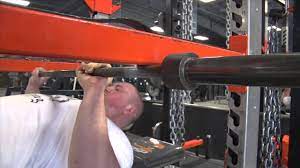Harnessing the Power of PAP
by Josh Bryant and Joe Giandonato

Peter Edgette executing isometric bench presses in part for a PAP effect.
Ben Johnson squatted 600 pounds 10 minutes prior to running a 9.79-second 100-meter dash world-record in 1988!
Was Johnson’s coach, Charlie Francis, outhouse rat crazy or drunker than Cooter Brown?
Jeremy Hoornstra did a maximal isometric contraction on the bench press eight minutes prior to setting the all-time world record in the 275-weight class in the bench press. Was article co-author, Hoornstra’s coach, Josh Bryant, playing with a full deck?
Jeremy’s maximal isometric contraction prior to bench pressing a world record of 672, weighing 247.
Actually both of these athletes exploited PAP to set world-records!
What is PAP?
PAP is like, “Lifting a half-can of water when you think it’s full,” in the words of former Soviet sports scientist, Yuri Verkhoshansky.
So, whether you’re a strength athlete looking to blast through plateaus, a traditional athlete pursuing explosive power, or a bouncer at a Japanese dive bar preparing for dollar Sake night—you can benefit from PAP, short for post-activation potentiation within your training.
The PAP secret was pried from Soviet sports scientists after American researchers fed them one too many Vodkas at Rumochnaya Bukhuchet (famous Moscow Dive Bar) after a sports science conference—okay, maybe not. All joking aside, many believe PAP had its origins in the former USSR and was first introduced to the Western world in 1986 at the Moscow Institute of Sport.
Others believe the PAP gospel was brought to light by East German physiologist, Dietmar Schmidbleichter, after his work was translated to English in the 1980s.
Regardless of origin, PAP first started appearing in mainstream fitness media in early 2000s and was popularized by the late iconoclastic strength coach, Charles Poliquin.
The bottom line is the incorporation of PAP methodologies have produced monumental improvements in neuromuscular performance in many athletes!
Demystifying and Deconstructing PAP
Within training circles, PAP has been mystically viewed as a purple unicorn of sorts, difficult to explain and even trickier to program. Coaches and athletes alike are left pondering how PAP can be leveraged to stimulate improvements in biomotor skills and ultimately kick ass on the field of play!
PAP can be described as an acutely enhanced muscle contraction following the exposure to a rapid and systemic contractile stimulus, also known as a voluntary conditioning contraction, such as a heavy compound lift (including maximal isometric contractions), a high speed movement, such as a plyometric exercise, medicine ball throw, or an acceleration drill — movements which require a lightning strike quick recruitment, activation, and synchronization of motor units.
In other words, PAP is the increase in strength and/or rate of force development (RFD) that occurs as a result of previous activation of the muscle because of greater CNS stimulation.
Stay with us, we are going to nerd out for a New York minute so you can better understand PAP and ultimately be able to apply it to your training.
No one is sure of the exact mechanism of PAP but it is believed because of the aforementioned contractile stimulus, is the release of myosin light chain kinase, a regulatory enzyme responsible for enabling their phosphorylation which facilitates a rushed and more powerful binding of contractile proteins myosin and actin. In addition, a band of higher threshold (more powerful) motor units wake up as the movement requiring massive effort serves as a neurological alarm clock of sorts.
The other proposed mechanism is that conditioning contraction (heavy or explosive) causes increased synaptic excitation within the spinal cord, resulting in increased subsequent force generating capabilities in the involved muscle groups.
What we do know is PAP is most effectively applied to fast-twitch or Type II muscle fibers and enhances maximal intensity activities that depend on these fibers (sprinting, weightlifting, throwing and jumping).
An example of PAP is a throwback to the days of packing up and moving out of your family’s house as you go to college or run away with the circus. You load up the moving truck and/or two-decade old Dodge Caravan with larger and heavier items, often removing them from your bedroom first. You and your help for the day first hoist a dresser and load it in the cargo area of the vehicle. Next, you grab a nightstand, lamp, or bookshelf. Magically, they seem to be much lighter than they normally are, all thanks to PAP!
If the moving drags ass all day, eventually you hit a wall. That’s why no one actually feels stronger or revitalized after a moving day.
The premise of PAP is starting a training session by performing an explosive movement or with circa maximal loads while freshest then reducing the amount of effort required (intensity and load) throughout subsequent sets. All done with avoiding excessive fatigue—PAP is in no form pre-exhaust! In the words of Lee Haney, “Stimulate don’t annihilate!”
PAP is advantageous to motor learning as its initial efforts require a rapid summation of force which is sustained throughout successive efforts as load is lessened.
The practice of powerbuilding, in which improvements in strength and body composition are simultaneously pursued, draws from PAP, as does Reverse Pyramid Training and Wave Loading.
Final Thoughts
PAP allows athletes to increase total force production and RFD in acute bouts. While the short-term benefit is immediate performance enhancement, overtime this acute benefit morphs into long-term adaptations including, but not limited to, enhanced speed, strength, power muscle hypertrophy and neuromuscular facilitation.
PAP only works when fatigue does not off-set RFD or limit strength capabilities.
PAP is highly individualized; some athletes respond better than others, some are even non-responders. PAP is generally a case where the rich get richer because it primarily benefits well trained, elite athletes with highest percentage of fast-twitch muscle fibers.
In part II, we will take a look at the application of PAP and how to know if it will work for you and your athletes.

Unlock the potential of PAP principles for strength with Josh’s XXL Strength and Size Program.
Get it HERE
References
Seitz, L.B., Trajano, G.S., & Haff, G.G. (2014). The back squat and the power clean: Elicitation of different degrees of potentiation. International Journal of Sports Physiology and Performance, 3, 1, 55-67.
Stone, M.H., Sands, W.A., Pierce, K.C., & Ramsey, M.W. (2008). Power and power potentiation among strength-power athletes: preliminary study. International Journal of Sports Physiology and Performance, 3, 1, 55-67.
Freitas, T.T., Calleja-Gonzales, Alarcon, F., & Alcaraz, P.E. (2016). Acute effects of two different resistance circuit training protocols on performance and perceived exertion in semiprofessional basketball players. Journal of Strength and Conditioning Research, 30, 2, 407-414.
Lorenz, D. (2011). POSTACTIVATION POTENTIATION: AN INTRODUCTION. International Journal of Sports Physical Therapy, 6(3), 234–240
